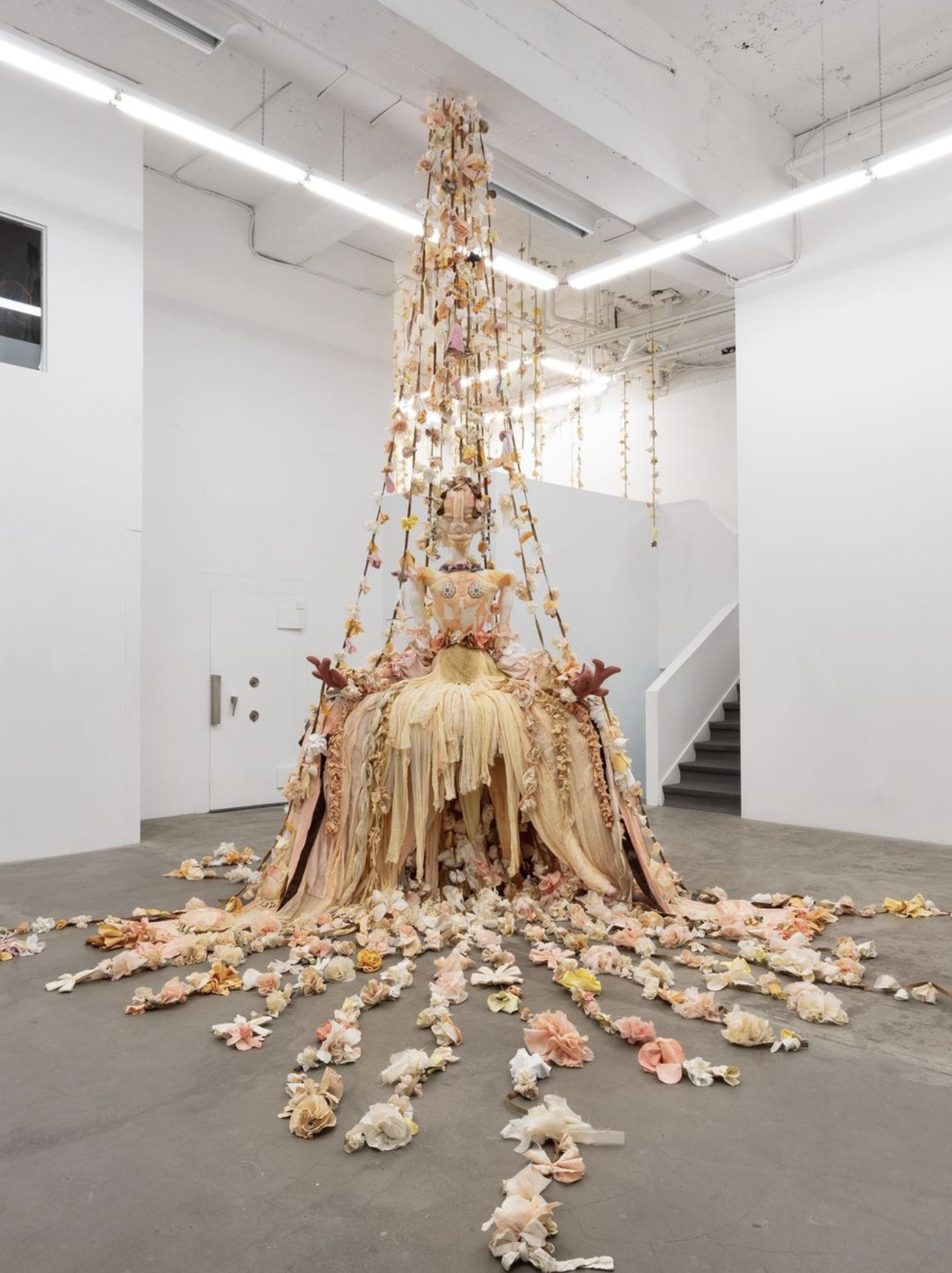Material Memories
Observe the objects that surround you. Your eyes will linger on various items that hold some significance — these may include family objects or personal possessions connected to fond memories, a momentous occasion, or maybe a soon-to-be-fulfilled aspiration. You may suddenly become sensitive to how these exceedingly familiar, sometimes even banal, items make you feel as they reverberate a sense of value. Over time, it becomes apparent that such objects radiate with energy strong enough to affect you, often deeply. Through this growing appreciation for what philosopher Jane Bennett calls “vibrant matter,” you gradually enter a fuller understanding of your part in the ecology of things, a vast and complex network of both human and non-human experience.
Feminist artists have been keenly aware of and interested in the ways in which everyday materials inform and shape our experiences of the world. Their boundless interpretations out of our collective materiality shapes our understanding of the objects to which we attach significance and memory.
There is a renewed interest in thinking through materiality as artists grapple with the complex social, political and ecological implications of an increasingly globalized world.
Well before Picasso’s African-inspired relief construction Still Life (1914) appeared in European museums, Black artists have been creating works that contemplate and utilize the material world — both manufactured and natural. Often, their commitment to assembling, remixing, juxtaposing, recycling, repurposing and hacking has been borne out of social and economic necessity. Through creative interaction between the physical, natural and the immediate, such artists offer ways for us to think about Black experiences by way of the ongoing impacts of colonialism, imperialism and other historical processes. By imbuing objects with this weighted meaning, they open new pathways for thinking comprehensively about cultural heritage.
Kapwani Kiwanga and Tau Lewis take significantly different approaches to their artistic projects, and yet both artists challenge us to consider how our social realities are rooted in ecological relation. Both arrive at intriguing examinations of materials and their affect within Black experiences, using everyday objects imbued with personal, historical and political memories that inform our understanding of the world.
Kapwani Kiwanga, Flowers for Africa, ongoing. Installation view, MOCA Toronto. Protocol of assembly and display including archival iconography to guide the reconstruction of a floral arrangement consisting of cut flowers. Photographer: Toni Hafkenscheid. COURTESY OF THE ARTIST AND GALERIE POGGI, PARIS.
Kapwani Kiwanga
In the work of artist Kapwani Kiwanga, concerns with materiality, power and history are reached through a relentless research-driven examination of the archive. Kiwanga produces work that encourages the viewer to think about history beyond the human. She is well-lauded for her explorations and received both the Sobey Art Award and the inaugural Frieze Artist Award in 2018, and more recently, the 2020 Prix Marcel Duchamp. Kiwanga, born and raised in Hamilton, Ont., but now living and working in Paris, studied anthropology and comparative religion at McGill University before embarking on a career in art. This academic background grounds her artistic practice — which includes sculpture, installation, photography and film — in theoretical directions that often references Afrofuturism and African political histories and trajectories.
Nature, architecture, colour, politics and geography, among other subjects, form the impetus behind Kiwanga’s ongoing artistic endeavour. In positioning herself as a detached interpreter, she creates “exit strategies,” ways of considering the historical ruptures and fissures that present fleeting opportunities to think and imagine anew.
In Flowers for Africa (2013-ongoing), Kiwanga makes use of archives connected to seminal moments in African political history. Referencing flowers in archival images, she recreates these arrangements to address the issues of history, time, power and political fragility. As artifacts associated with the exuberance and joy of independence ceremonies, Kiwanga sees the floral arrangements as symbols of the hopes and dreams of newly independent countries, while suggesting such sentiments are fragile and destined to decay. Flowers for Africa is more about interpretation and the limits of continuity than about re-enacting history.
The foliage that witnessed shifts in geopolitical power carries a cultural memory that can only be considered transient. When the flowers begin to wilt and fall apart in their displays, we are left to wonder how a similar undoing of post-colonial struggles have affected contemporary realities. The realization is jarring: post-colonialism may have begun to die the minute it was attempted.
Kapwani Kiwanga with Shady, 2018. Shade cloth and steel, 410 x 400 x 810 cm. Photographer: Mark Blower. Courtesy of Mark Blower/Frieze.
For all its interest in the political, Kiwanga’s work has veered away from explicit engagement with current events. There is no obvious commentary on police brutality against Black people; there is no grappling, for example, with the treatment of Africans in France, where the artist has worked for over a decade. Rather, Kiwanga seems more interested in digging into the root of things, positing ways of rethinking what the archive leads her to.
Kiwanga had noticed ginseng being grown under massive polyethylene row covers in fields near First Nations territory in Haldimand, Ont. The relocation of a cash crop to a region deeply connected to histories of land appropriation and genocide shows how new forms of colonialism are repeated, manifested and maintained in the twenty-first century. In Shady (2018), Kiwanga uses shade cloth (which the artist first encountered in agricultural settings) as a metaphor for thinking about how technologies influence notions of visibility and power. In this sculpture-based work, multicoloured cloths stretch across large steel frames that obscure both sightlines and movement. While the shade cloth darkens one’s view through the structure, its mesh-like texture presents micro-sized holes that permit a controlled amount of light and air to pass through.
Shade, in this provocative context, casts not only shadow or doubt over the validity of economic enterprise but also signifies how we are implicated in power relations that echo through time and space.
Kapwani Kiwanga, Nations: Cap Français, 2020. Mixed textiles. Photographer: Maison Louis Carré. COURTESY OF GALERIE POGGI, PARIS via Instagram.
In Nations (2020), Kiwanga furthers her interest in the cultural and political vibrancy of fabrics by creating flag-like works that blend 18th century Haitian revolutionary history with concern for the syncretic religion of Vodou. Inspired by a trip to the Caribbean in 2009, Kiwanga uses beaded and embroidered quilts to capture key moments of the first and only successful slave revolt in the Americas. Assembled by a team of Haitian textile workers who were given only basic direction from the artist, the resulting works present colourful flags that vividly channel ceremonial Haitian loa, or spirits, that were immensely important to the slaves who overthrew European bondage. The collaborative, transplanted way the flags are produced reinforces the connective linkages of the African diaspora, which evoke the enormous challenges that Haiti has faced ever since the triumphant days of Haitian general Toussaint L’Ouverture and the Haitian Revolution.
Tau Lewis
Jamaican-Canadian artist Tau Lewis, who currently lives and works in Brooklyn, N.Y., uses found, gathered and recycled materials to create sculpture-based portraits and quilts that explore themes of diaspora, identity, erasure, feminism and Afro-cosmology. Lewis undertakes hand-sewn, laborious processes that, in some cases, take years to complete — her work received the 2018 Frieze Frame Stand Prize.
Lewis employs arduous methods such as hand-sewing, carving, and assemblage to build intricate works that further her interest in healing historical and personal traumas. Lewis’ craft-based works use materials gathered from her environment; there is an emphasis on the autobiographical over the theoretical, and her works are deeply rooted in traditions long nurtured by women makers and Black American folk artists.
Tau Lewis, Sparkle & Sparkle’s Map Home, 2018. Mixed media sculpture. Courtesy of @taulewis via Instagram.
In Sparkle & Sparkle’s Map Home (2018), Lewis presents a sculpture of a woman sitting in a chair in front of a large textile quilt. The viewer is invited to ponder where Sparkle’s journey has taken her and what the quilt suggests about her past and future — the “map” has tools, photos, seashells and pieces of hardware woven into the fabric.
Tau Lewis, When last you found me here, 2019. Mixed media sculpture. Courtesy of @taulewis via Instagram.
In When last you found me here (2019) Lewis presents a collection of what she calls “bulletproof” figures or “time capsules” whose presences are not easily reduced to common understandings or depictions of Black peoples. Using plaster, wire, cloth and found objects, the work suggests an unknowable and otherworldly communion connecting the African diaspora to diverse and perhaps distant landscapes, geographies and memories.
Tau Lewis, Triumphant Alliance of the Ubiquitous Blossoms of Incarnate Souls, 2020. Mixed media sculpture. Courtesy of @taulewis via Instagram.
Triumphant Alliance of the Ubiquitous Blossoms of Incarnate Souls (2020) continues Lewis’ exploration of other realms and their possibilities for health, healing, love, care and wisdom. Using pastel palettes and fabrics such as bed sheets and curtains, these “soft portraits” generate associations with mothering, nurturing and reproduction. Lewis is interested in the ways in which materials hold and conceal affective memory and transmute knowledge of present, past and future. Race, gender and species is submerged here; the viewer is asked to abandon social constructs, categories and boundaries to enter a strange territory.
***
In reflecting on the way both artists use silence as a metaphor for the inexplicable, I am reminded of what Black feminist theorist Tina Campt writes in her important book Listening to Images (Duke University Press, 2017): “Attending to the infra-ordinary and the quotidian reveals why the trivial, the mundane, or the banal are in fact essential to the lives of the dispossessed and the possibility of black futurity.”
I am drawn into thinking about the reasoning behind the choices both Kiwanga and Lewis make: why do they seem to be more interested in the associative than the explicit? How does their work address Black aesthetics?
Of course, these questions lead to even more generative discussion and debate regarding the impossibility of categorizing Black life.
This article was published in the Fall/Winter 2021 issue of Studio Magazine.












